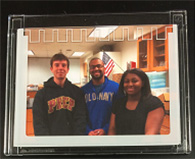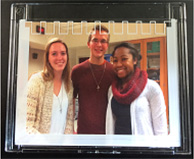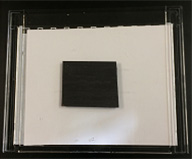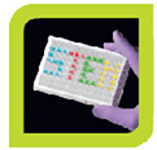Where Science and Art Connect
Have you or your students produced some artwork that you want to share? Show the rest of the community your ideas and creativity. How can science be represented in art? Artwork can be anything from instructional diagrams to abstract designs, and from serious to comical.
We've included links to some interesting science artwork to stimulate your creativity. See the creations of artists who use science in their art and add your contributions. Inspire and be inspired!
See the instructions for submitting your artwork and other materials at the bottom of this page.
STEM + Art/Design = STEAM
Perhaps you are using art as a science teaching tool. The term STEAM is starting to gain traction, and even has a Congressional caucus to promote it. There is increasing evidence to suggest that arts and creativity can increase innovation and, as important, achievement in science. If your curriculum includes STEAM, share your art and design. You can also share STEAM lesson plans, curricula, or other materials with the community. See the links below for information and ideas about STEAM.
Page Contents
Have your students made any artwork using pGLO? These fun pGLO plates were made by 7th grade students in the class of Essy Levy at the Bankstreet School for Children in New York.
Sherry Annee from Brebeuf Jesuit Preparatory School shares her idea of making SDS-PAGE Gel Cassette Photo Frame as gifts for her students!
After students conduct a lab investigation to study proteins using SDS-PAGE gels, the used gel cassettes can be repurposed into photo frames. Teachers can take photos to document their students’ time in class, frame them in the used SDS-PAGE gel cassettes and give them to the students at the end of the year as memory keepsakes. Simply print photos, adhere photos between the two halves of the cassette (i.e., the photo is sandwiched between the front and back covers of the cassette), and glue a magnet to the back of the cassette.



 Your students can make microplate artwork while practicing accurate pipetting skills. This activity will teach them to pipet microliter volumes, assess pipetting accuracy, and navigate 96-well microplates. Download this Microplate Art Pipetting STEAM Activity now to combine science and art in your classroom.
Your students can make microplate artwork while practicing accurate pipetting skills. This activity will teach them to pipet microliter volumes, assess pipetting accuracy, and navigate 96-well microplates. Download this Microplate Art Pipetting STEAM Activity now to combine science and art in your classroom.
Luke Jerram produces amazing glass artwork that accurately represents a selection of disease-causing organisms. Browse Jerram's gallery and check out a video about the artist and his work.
Artist Kevin Van Aelst makes some interesting artwork, including some that combines biology and food. Did you know gummy worms can look just like human chromosomes identified with chromosome paint?
A little background: The binding of a fluorescently labeled sequence of DNA or RNA to cellular DNA is called fluorescent in situ hybridization, or FISH. When several different DNA or RNA sequences are identified, each with a unique fluorescent tag, this is known as chromosome painting. The images of chromosomes are rendered in false colors to aid identification. Each pair of chromosomes has a distinct color pattern. Nature Education provides a comprehensive explanation of FISH on Scitable. In the gummy worm artwork you can see the 22 pairs, plus the sex chromosomes. Each pair is the correct length relative to the other pairs.
How about demonstrating mitosis using Krispy Kreme donuts? See the series of images as one donut becomes two.
Bacteria are being used to create artwork. Here are some examples. Perhaps you and your students could make green fluorescent artwork with the pGLO™ Plasmid and GFP kits!
A former microbiologist has combined microbiological procedures with the photographic process to make portraits and other images using bacteria. Einstein in bacteria! To see some bacterial portraits and other creations, visit Zachary Copfer’s blog, Science to the Power of Art.
Here are a few examples of petri dish artwork using glowing bacteria:
From a Doctor Who fan, a Dalek made of E. coli. CONTAMINATE!
This colorful beach scene was drawn with eight strains of glowing bacteria.
Non-science majors at the University of Chicago have a petri dish art gallery.
Artist Hunter Cole has made living drawings with bioluminescent bacteria. See the drawings emerge as the bacteria grow. Watch the video and visit Cole’s website to read about the art and also see a picture of one of the living artworks under moonlight.
Make a DNA bracelet to go with your DNA necklace from the Genes in a Bottle™ kit. There are several options depending on resources available, time and skill.

A simple fun bracelet involves taking two pieces of elastic about 30 cm long and 4 differently colored beads, one corresponding to each DNA base. Decide which color is which DNA base, one color each for A, C, G, and T. Then pick a DNA sequence. Here are some suggestions from genome.gov. The two pieces of elastic are knotted together a few centimeters from the end and then the chosen sequence is threaded on one piece of elastic, which is then knotted to keep the beads in place. Using base pairing rules (A with T, and C with G) the complementary sequence is threaded on the other piece of elastic. After threading on all the beads, knot the second piece of elastic and then knot the two pieces of elastic together. Then knot the ends together to form the bracelet.
Spell Your Name with DNA
Another suggestion is to have the students spell their names (or something else) in DNA, using the single-letter triplet code. Give the students a table of the single-letter code for the triplets, and first have them find the six letters that do not have a triplet code. Decide what to do about these letters (sometimes B (Asx) is used to denote either asparagine and aspartic acid, and Z (Gsx) for glutamine and glutamic acid). Then make a bracelet as above.
Make a Double Helix Bracelet
There are a number of methods for making a friendship-style bracelet that spirals and looks like a double helix. This short video illustrates a simple pattern; this video provides detailed instructions and diagrams.
Here are a number of links for sites about STEAM.
- STEAM Ahead: Merging Science and Arts Education on the PBS News Hour Blog
- School Transformation through Arts Integration is about art integration and features a middle school that has raised student achievement
- Two videos from the Duke STEAM Challenge: SEED and Between the Paths
- From STEM to STEAM: Science and Art Go Hand-in-Hand a commentary in Scientific American
- Mounds View School District has implemented a STEAM curriculum for all middle schools
- STEAM for Institutions of Higher Education although this blog is aimed at Higher Education, it describes many interesting concepts applicable to many levels
- STE[+A]M Connect at University of California, San Diego for grades K–16
- STEM to STEAM is based at the Rhode Island School of Design
- Art & Science Collaborations, Inc.
- House Resolution 51 to promote STEAM
- Gurnon D et al. (2013). Integrating Art and Science in Undergraduate Education. PLoS Biol 11: e1001491. doi:10.1371/journal.pbio.1001491
Please complete the submission form and email your materials to explorer@bio-rad.com.
Types of artwork could include cartoons, photographs, drawings, paintings, computer-generated art, posters, images of three-dimensional art, and video. Let your imagination and science go. Acceptable formats are .txt, .doc/.docx, .jpg, .gif, .png, .mp4, .flv, .swf, .mov, .xls/.xlsx, .ppt/.pptx, and pdf.
Describe the background/concept of the artwork in the Comments section, including which Biotechnology Explorer™ products are relevant to the creation of the artwork and what led to the inspiration for the artwork. Please make sure that contact details are filled in. If you want to provide any other credits (other educators, etc.), please state this in the Comments section along with any other relevant information.




